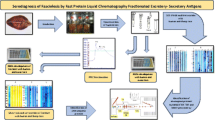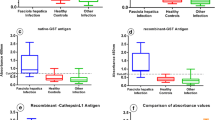Abstract
Fascioliasis, a food- and water-borne trematodiasis, has been identified as a public health threat by the World Health Organization, with millions of people estimated to be infected or at risk of infection worldwide. We developed an immunochromatographic test (ICT) as a point-of-care (POC) tool for the rapid serodiagnosis of human fascioliasis caused by Fasciola gigantica and evaluated their diagnostic ability. Two tests were developed using antigens from adult F. gigantica excretory-secretory (ES) product and recombinant F. gigantica cathepsin L (rFgCL). Sera from 12 patients with parasitologically proven fascioliasis caused by F. gigantica, 18 with clinically suspected fascioliasis, 65 with other parasitic infections, and 30 healthy controls were used. Using a cutoff of > 0.5 for antibody detection, the sensitivity, specificity, positive predictive value, negative predictive value, and accuracy of the ES-based ICT method were 100%, 98.9% 96.8%, 100%, and 99.2%, respectively, and those of the rFgCL-based ICT method were 86.7%, 93.7%, 81.3%, 95.7%, and 92.0%, respectively. The concordance between the two methods was 91.2%. Tests using F. gigantica ES and rFgCL antigens can be employed quickly and easily as POC diagnostic tools. They can be used to support the clinical diagnosis of human fascioliasis gigantica and in large-scale surveys in endemic areas throughout tropical regions without necessitating additional facilities or ancillary supplies.


Similar content being viewed by others
References
Agatsuma T, Arakawa Y, Iwagami M, Honzako Y, Cahyaningsih U, Kang SY, Hong SJ (2000) Molecular evidence of natural hybridization between Fasciola hepatica and F. gigantica. Parasitol Int 49:231–238
Anuracpreeda P, Chawengkirttikul R, Sobhon P (2016) Immunodiagnosis of Fasciola gigantica infection using monoclonal antibody-based sandwich ELISA and immunochromatographic assay for detection of circulating cathepsin L1 protease. PLoS One 11:e0145650
Carnevale S, Rodriguez MI, Guarnera EA, Carmona C, Tanos T, Angel SO (2001) Immunodiagnosis of fasciolosis using recombinant procathepsin L cystein proteinase. Diagn Microbiol Infect Dis 41:43–49
Clerc O, Greub G (2010) Routine use of point-of-care tests: usefulness and application in clinical microbiology. Clin Microbiol Infect 16:1054–1061
Cornelissen JB, Gaasenbeek CP, Borgsteede FH, Holland WG, Harmsen MM, Boersma WJ (2001) Early immunodiagnosis of fasciolosis in ruminants using recombinant Fasciola hepatica cathepsin L-like protease. Int J Parasitol 31:728–737
Cwiklinski K, O’Neill SM, Donnelly S, Dalton JP (2016) A prospective view of animal and human fasciolosis. Parasite Immunol 38:558–568
Elkins DB, Haswell-Elkins M, Anderson RM (1986) The epidemiology and control of intestinal helminths in the Pulicat Lake region of southern India. I. Study design and pre- and post-treatment observations on Ascaris lumbricoides infection. Trans R Soc Trop Med Hyg 80:774–792
Galen RS (1980) Predictive value and efficiency of laboratory testing. Pediatr Clin N Am 27:861–869
Goldfarb AR, Saidel LJ, Mosovich E (1951) The ultraviolet absorption spectra of proteins. J Biol Chem 193:397–404
Hashimoto K, Watanobe T, Liu CX, Init I, Blair D, Ohnishi S, Agatsuma T (1997) Mitochondrial DNA and nuclear DNA indicate that the Japanese Fasciola species is F. gigantica. Parasitol Res 83:220–225
Hassan MM, Mostafa NE, Ramadan M, Nassar A, Hassounah O, Omar O (2000) Anti-Fasciola IgG isotypes among patients with fascioliasis before and after treatment. J Egypt Soc Parasitol 30:505–510
Hassan MM, Matar MA, Mowafy N, Saleh A, el-S e-B, Awad A, Ramadan NI (2002) Dot ELISA for measuring anti-Fasciola IgG isotypes among patients with fascioliasis. J Egypt Soc Parasitol 32:571–578
Intapan PM, Maleewong W, Wongkham C, Tomanakarn K, Ieamviteevanich K, Pipitgool V, Sukolapong V (1998) Excretory-secretory antigenic components of adult Fasciola gigantica recognized by infected human sera. Southeast Asian J Trop Med Public Health 29:579–583
Intapan PM, Tantrawatpan C, Maleewong W, Wongkham S, Wongkham C, Nakashima K (2005) Potent epitopes derived from Fasciola gigantica cathepsin L1 in peptide-based immunoassay for the serodiagnosis of human fascioliasis. Diagn Microbiol Infect Dis 53:125–129
Intapan PM, Khotsri P, Kanpittaya J, Chotmongkol V, Maleewong W, Morakote N (2008) Evaluation of IgG4 and total IgG antibodies against cysticerci and peptide antigens for the diagnosis of human neurocysticercosis by ELISA. Asian Pac J Allergy Immunol 26:237–244
Janwan P, Intapan PM, Yamasaki H, Rodpai R, Laummaunwai P, Thanchomnang T, Sanpool O, Kobayashi K, Takayama K, Kobayashi Y, Maleewong W (2016) Development and usefulness of an immunochromatographic device to detect antibodies for rapid diagnosis of human gnathostomiasis. Parasit Vectors 12(9):14
Lowry OH, Rosebrough NJ, Al F, Randall RJ (1951) Protein measurement with the Folin phenol reagent. J Biol Chem 193:265–275
Maleewong W, Intapan PM, Wongkham C, Tomanakan K, Daenseekaew W, Sukeepaisarnjaroen W (1996) Comparison of adult somatic and excretory-secretory antigens in enzyme-linked immunosorbent assay for serodiagnosis of human infection with Fasciola gigantica. Southeast Asian J Trop Med Public Health 27:566–569
Maleewong W, Wongkham C, Intapan PM, Pipitgool V (1999) Fasciola gigantica-specific antigens: purification by a continuous-elution method and its evaluation for the diagnosis of human fascioliasis. Am J Trop Med Hyg 61(4):648–651. https://doi.org/10.4269/ajtmh.1999.61.648
Marcilla A, Bargues MD, Mas-Coma S (2002) A PCR-RFLP assay for the distinction between Fasciola hepatica and F. gigantica. Mol Cell Probes 16:327–333
Martínez-Sernández V, Muiño L, Perteguer MJ, Gárate T, Mezo M, González-Warleta M, Muro A, Correia da Costa JM, Romarís F, Ubeira FM (2011) Development and evaluation of a new lateral flow immunoassay for serodiagnosis of human fasciolosis. PLoS Negl Trop Dis 5:e1376
Mas-Coma S (2004) Human fascioliasis. In: Cotruvo JA, Dufour A, Rees G et al (eds) Waterborne zoonoses: identification, causes and control. World Health Organization (WHO), International Water Association Publishing, London, pp. 305–322
Mas-Coma S, Bargues MD, Valero MA (2005) Fascioliasis and other plant-borne trematode zoonoses. Int J Parasitol 35:1255–1278
Mas-Coma S, Valero MA, Bargues MD (2009) Fasciola, lymnaeids and human fascioliasis, with a global overview on disease transmission, epidemiology, evolutionary genetics, molecular epidemiology and control. Adv Parasitol 69:41–146
Mas-Coma S, Adela Valero M, Dolores Bargues M (2015) Fasciola and Fasciolopsis. In: Xiao L, Ryan U, Feng Y (eds) Biology of food borne parasites, 1st edn. Taylor and Francis Group, New York, pp 371–404
Mas-Coma S, Bargues MD, Valero MA (2018) Human fascioliasis infection sources, their diversity, incidence factors, analytical methods and prevention measures. Parasitology 145:1665–1699
O’Neill SM, Parkinson M, Strauss W, Angels R, Dalton JP (1998) Immunodiagnosis of Fasciola hepatica infection (fascioliasis) in a human population in the Bolivian Altiplano using purified cathepsin L cysteine proteinase. Am J Trop Med Hyg 58:417–423
O’Neill SM, Parkinson M, Dowd AJ, Strauss W, Angels R, Dalton JP (1999) Immunodiagnosis of human fascioliasis using recombinant Fasciola hepatica cathepsin L1 cysteine proteinase. Am J Trop Med Hyg 60:749–751
Periago MV, Valero MA, Panova M, Mas-Coma S (2006) Phenotypic comparison of allopatric populations of Fasciola hepatica and Fasciola gigantica from European and African bovines using a computer image analysis system (CIAS). Parasitol Res 99:368–378
Periago MV, Valero MA, El Sayed M, Ashrafi K, El Wakeel A, Mohamed MY, Desquesnes M, Curtale F, Mas-Coma S (2008) First phenotypic description of Fasciola hepatica/Fasciola gigantica intermediate forms from the human endemic area of the Nile Delta, Egypt. Infect Genet Evol 8:51–58
Rokni MB, Massoud J, O’Neill SM, Parkinson M, Dalton JP (2002) Diagnosis of human fasciolosis in the Gilan province of northern Iran: application of cathepsin L-ELISA. Diagn Microbiol Infect Dis 44:175–179
Sahba GH, Arfaa F, Farahmandian I, Jalali H (1972) Animal fascioliasis in Khuzestan, southwestern Iran. J Parasitol 58:712–716
Strauss W, O’Neill SM, Parkinson M, Angels R, Dalton JP (1999) Diagnosis of human fasciolosis: detection of anti-cathepsin L antibodies in blood samples collected on filter paper. Am J Trop Med Hyg 60:746–748
Tantrawatpan C, Maleewong W, Wongkham C, Wongkham S, Intapan PM, Nakashima K (2005) Serodiagnosis of human fascioliasis by a cystatin capture enzyme-linked immunosorbent assay with recombinant Fasciola gigantica cathepsin L antigen. Am J Trop Med Hyg 72:82–86
Tantrawatpan C, Maleewong W, Wongkham C, Wongkham S, Intapan PM, Nakashima K (2007) Evaluation of immunoglobulin G4 subclass antibody in a peptide-based enzyme-linked immunosorbent assay for the serodiagnosis of human fascioliasis. Parasitology 134:2021–2026
Valero MA, Periago MV, Pérez-Crespo I, Angles R, Villegas F, Aguirre C, Strauss W, Espinoza JR, Herrera P, Terashima A, Tamayo H, Engels D, Gabrielli AF, Mas-Coma S (2012) Field evaluation of a coproantigen detection test for fascioliasis diagnosis and surveillance in human hyperendemic areas of Andean countries. PLoS Negl Trop Dis 6:e1812
Watanabe S (1965) A revision of genus Fasciola in Japan with particular reference to F. hepatica and F. gigantica. In: Morishita K, Kamiya Y, Matsubayashi H (eds) Progress of medical parasitology in Japan. Megura Parasitological Museum, Tokyo, pp 359–381
Wongkham C, Tantrawatpan C, Intapan PM, Maleewong W, Wongkham S, Nakashima K (2005) Evaluation of immunoglobulin G subclass antibodies against recombinant Fasciola gigantica cathepsin L1 in an enzyme-linked immunosorbent assay for serodiagnosis of human fascioliasis. Clin Diagn Lab Immunol 12:1152–1156
Yamasaki H, Aoki T, Oya H (1989) A cysteine proteinase from the liver fluke Fasciola spp.: purification, characterization, localization and application to immunodiagnosis. Jpn J Parasitol 38:373–384
Yamasaki H, Mineki R, Murayama K, Ito A, Aoki T (2002) Characterisation and expression of the Fasciola gigantica cathepsin L gene. Int J Parasitol 32:1031–1042
Acknowledgments
We would like to thank Dylan Southard through Khon Kaen University Publication Clinic (Thailand) for the English editing of this manuscript. We also extend our gratitude to Jitaporn Harasan from the Mekong Health Science Research Institute for providing such an effective immunochromatographic technique.
Funding
This study was supported by a Distinguished Research Professor Grant from the Thailand Research Fund (grant no. DPG6280002) awarded to P.M.I. and W.M., scholarships provided to L.S. under the Khon Kaen University Post-Doctoral Training Program of the Graduate School and Research Affairs (grant no 60164), Faculty of Medicine, Khon Kaen University to O.S. and W.M. (grant no. DR63101), and Research Program on Emerging and Re-Emerging Infectious Diseases from the Japan Agency for Medical Research and Development (Kansensho Jitsuyoka-Ippan grant nos. JP17fk0108119, JP18fk0108046, JP19fk0108046) to Y.M.
Author information
Authors and Affiliations
Contributions
Conceptualization: LS, HY, WM, and PMI.
Methodology: LS, HY, YM, OS, RR, PJ, and PB.
Formal analysis and investigation: LS, HY, YM, PB, WM, and PMI.
Writing-original draft preparation: LS, HY, YM, OS, RR, PJ, PB, and PMI.
Writing-review and editing: LS, HY, PJ, WM, and PMI.
Supervision: HY, WM, and PMI.
All authors read and approved the final manuscript.
Corresponding author
Ethics declarations
Conflict of interest
The authors declare that they have no conflict of interest.
Ethical standards
This study was performed in compliance with all relevant regulations and guidance. The study protocol was approved by the Khon Kaen University Ethics Committee for Human Research (HE611507) with the relevant guidelines and regulations regarding ethical principles for medical research involving human subjects detailed in the Declaration of Helsinki. Informed consent was obtained from adult participants and from parents or legal guardians of minors. The use of human sera was approved by the Medical Ethics Committee of the National Institute of Infectious Diseases (Tokyo, Japan; No. 177). Experiments involving the use of vertebrate animals were approved by the Khon Kaen University Animal Ethics Committee according to the National Research Council of Thailand’s animal experimentation ethics regulations (AEMDKKU 002/2018).
Disclaimer
The content of this report is solely the responsibility of the authors and does not necessarily represent the official views of the supportive grant providers.
Additional information
Section Editor: Xing-Quan ZHU
Publisher’s note
Springer Nature remains neutral with regard to jurisdictional claims in published maps and institutional affiliations.
Electronic supplementary material
ESM 1
(PDF 302 kb)
Rights and permissions
About this article
Cite this article
Sadaow, L., Yamasaki, H., Morishima, Y. et al. Effectiveness of Fasciola gigantica excretory-secretory and recombinant cathepsin L antigens for rapid diagnosis of human fascioliasis using immunochromatographic devices. Parasitol Res 119, 3691–3698 (2020). https://doi.org/10.1007/s00436-020-06907-w
Received:
Accepted:
Published:
Issue Date:
DOI: https://doi.org/10.1007/s00436-020-06907-w




